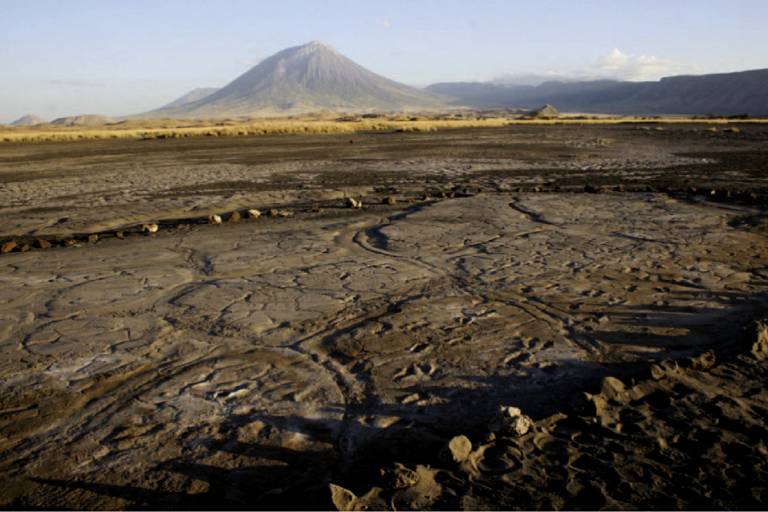Fossilised hominin footprints in the shadow of the Mountain of God may be between 6,000 and 19,000 years of age
12 October 2016
A team of archaeologists report on the radioisotopic age, formation, and preservation of a late Pleistocene human footprint site in northern Tanzania on the southern shore of Lake Natron near the village of Engare Sero.
 Over 400 human footprints, as well as tracks of zebra and bovid, are preserved in a series of volcaniclastic deposits. Based on field mapping along with geochemical and grain-size analyses, they propose that these deposits originated as proximal volcanic material from the nearby active volcano, Oldoinyo L'engai, and were then fluvially transported to the footprint site. Stable isotope results (δ18O and δ13C) suggest that the footprints were originally emplaced on a mudflat saturated by a freshwater spring and were later inundated by the rising alkaline waters of Lake Natron. They employed the 40Ar/39Ar and 14C dating methods to investigate the age of the site and determined that the footprint level is older than 5760 ± 30 yrs. BP and younger than 19.1 ± 3.1 ka. These radioisotopic ages are supported by stratigraphic correlations with previously documented debris avalanche deposits and the stable isotope signatures associated with the most recent highstand of Lake Natron, further constraining the age to latest Pleistocene. Since modern humans (Homo sapiens) were present in Africa ca. 200 ka, Engare Sero represents the most abundant and best-preserved footprint site of anatomically modern Homo sapiens currently known in Africa. Fossil footprints are a snapshot in time, recording behavior at a specific moment in history; but the actual duration of time captured by the snapshot is often not well defined. Through analog experiments, the team of scientists constrain the depositional window in which the prints were made, buried, and ultimately preserved to within a few hours to days or months.
Over 400 human footprints, as well as tracks of zebra and bovid, are preserved in a series of volcaniclastic deposits. Based on field mapping along with geochemical and grain-size analyses, they propose that these deposits originated as proximal volcanic material from the nearby active volcano, Oldoinyo L'engai, and were then fluvially transported to the footprint site. Stable isotope results (δ18O and δ13C) suggest that the footprints were originally emplaced on a mudflat saturated by a freshwater spring and were later inundated by the rising alkaline waters of Lake Natron. They employed the 40Ar/39Ar and 14C dating methods to investigate the age of the site and determined that the footprint level is older than 5760 ± 30 yrs. BP and younger than 19.1 ± 3.1 ka. These radioisotopic ages are supported by stratigraphic correlations with previously documented debris avalanche deposits and the stable isotope signatures associated with the most recent highstand of Lake Natron, further constraining the age to latest Pleistocene. Since modern humans (Homo sapiens) were present in Africa ca. 200 ka, Engare Sero represents the most abundant and best-preserved footprint site of anatomically modern Homo sapiens currently known in Africa. Fossil footprints are a snapshot in time, recording behavior at a specific moment in history; but the actual duration of time captured by the snapshot is often not well defined. Through analog experiments, the team of scientists constrain the depositional window in which the prints were made, buried, and ultimately preserved to within a few hours to days or months.Radioisotopic age, formation, and preservation of Late Pleistocene human footprints at Engare Sero, Tanzania
C.M. Liutkus-Pierce, B.W. Zimmer, S.K. Carmichael, W. McIntosh, A. Deino, S.M. Hewitt, K.J. McGinnis, T. Hartneya, J. Brett, S. Mana, D. Deocampo, B.G. Richmond, K. Hatala, W. Harcourt-Smith, B. Pobiner, A. Metallo, V. Rossi
DOI: http://dx.doi.org/10.1016/j.palaeo.2016.09.019
 Close
Close




